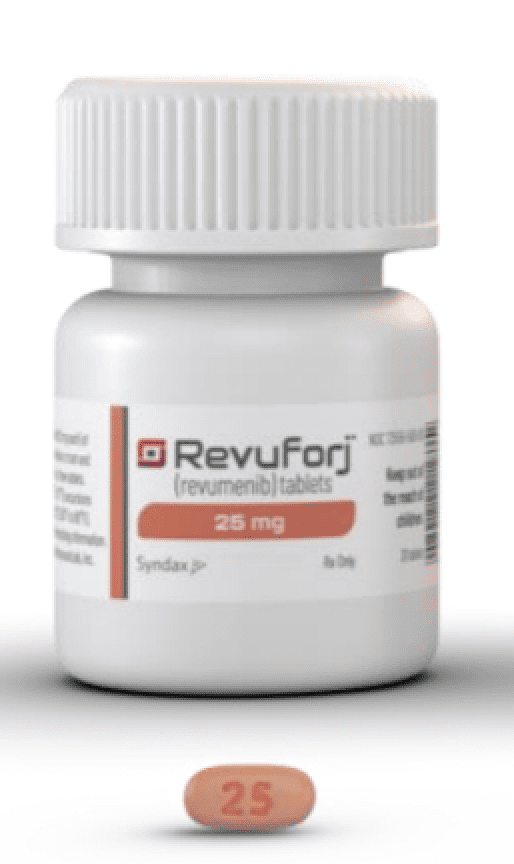Revuforj Side Effects
Generic name: revumenib
Note: This document provides detailed information about Revuforj Side Effects associated with revumenib. Some dosage forms listed on this page may not apply specifically to the brand name Revuforj.
Applies to revumenib: oral tablets.
Important warnings
This medicine can cause some serious health issues
-
Differentiation Syndrome
- Revumenib may cause differentiation syndrome, which can be fatal.1
- Signs and symptoms may include fever, dyspnea, hypoxia, pulmonary infiltrates, pleural or pericardial effusions, rapid weight gain or peripheral edema, hypotension, and renal dysfunction.1
- If differentiation syndrome is suspected, immediately initiate corticosteroid therapy and hemodynamic monitoring until symptom resolution.1
Side effects include:
Most common adverse reactions (≥20%): hemorrhage, nausea, phosphate increased, musculoskeletal pain, infection, AST increased, febrile neutropenia, ALT increased, parathyroid hormone intact increased, bacterial infection, diarrhea, differentiation syndrome, QTc prolongation, phosphate decreased, triglycerides increased, potassium decreased, appetite decreased, constipation, edema, viral infection, fatigue, alkaline phosphatase increased.
See also:
For healthcare professionals
Applies to revumenib: oral tablet.
General adverse events
The most common side effects were constipation, edema, decreased appetite, decreased phosphate, decreased potassium, ECG QT prolonged, fatigue, febrile neutropenia, bacterial infection, diarrhea, differentiation syndrome, hemorrhage, infection, increased AST, increased ALT, increased alkaline phosphatase, increased phosphate, increased parathyroid hormone intact, increased triglycerides, musculoskeletal pain, nausea, and viral infection.
The most frequently reported serious side effects included infection (24%), febrile neutropenia (19%), bacterial infection (17%), differentiation syndrome (12%), hemorrhage (9%), and thrombosis (5%).
The most common side effects resulting in dose interruption were differentiation syndrome, ECG QT prolonged, febrile neutropenia, hypokalemia, infection, and nausea.[Ref]
Cardiovascular
- Very common (10% or more): ECG QT prolonged (up to 29%), thrombosis (up to 10%)
- Frequency not reported: Cardiac failure, pericardial effusion, ventricular tachycardia, cardiac arrest
Thrombosis included disseminated intravascular coagulation, pulmonary embolism, cerebrovascular accident, deep vein thrombosis, embolism, hemorrhoids thrombosed, medical device site thrombosis, renal infarct, superficial vein thrombosis, thrombosis, and transient ischemic attack.
Dermatologic
- Frequency not reported: Rash
Endocrine
- Very common (10% or more): Increased parathyroid hormone intact (up to 33%)
- Frequency not reported: Hyperparathyroidism
Gastrointestinal
- Very common (10% or more): Nausea (up to 51%), diarrhea (up to 30%), constipation (up to 23%)
- Frequency not reported: Abdominal pain
Nausea included nausea and vomiting.
Diarrhea included diarrhea, colitis, and neutropenic colitis.
Hematologic
- Very common (10% or more): Hemorrhage (up to 53%), febrile neutropenia (up to 35%)
- Common (1% to 10%): Leukocytosis
Hemorrhage included epistaxis, contusion, petechiae, gingival bleeding, hematuria, mouth hemorrhage, hematoma, hemoptysis, hemorrhoidal hemorrhage, subdural hematoma, vaginal hemorrhage, catheter site hemorrhage, conjunctival hemorrhage, ecchymosis, hemorrhage intracranial, anal hemorrhage, brain stem hemorrhage, eye hematoma, gastrointestinal hemorrhage, genital contusion, hematochezia, injection site hematoma, lower gastrointestinal hemorrhage, melena, mucosal hemorrhage, oral contusion, pulmonary, upper gastrointestinal hemorrhage, and vitreous hemorrhage.
Hepatic
- Very common (10% or more): Increased AST (up to 37%), increased ALT (up to 33%)
Hypersensitivity
- Frequency not reported: Drug hypersensitivity
Metabolic
- Very common (10% or more): Decreased appetite (up to 24%)
- Frequency not reported: Hyponatremia, hyperkalemia
Musculoskeletal
- Very common (10% or more): Musculoskeletal pain (up to 42%)
Musculoskeletal pain included back pain, arthralgia, pain in extremity, neck pain, myalgia, musculoskeletal chest pain, myositis, flank pain, musculoskeletal discomfort, and musculoskeletal pain.
Nervous system
- Frequency not reported: Taste disorder, syncope, headache, paresthesia
Ocular
- Frequency not reported: Cataract
Other
- Very common (10% or more): Increased phosphate (up to 50%), infection (up to 41%), bacterial infection (up to 31%), differentiation syndrome (up to 29%), decreased phosphate (up to 25%), increased triglycerides (up to 25%), decreased potassium (up to 24%), viral infection (up to 23%), edema (up to 23%), fatigue (up to 22%), increased alkaline phosphatase (up to 21%), increased cholesterol (up to 19%), increased corrected calcium (up to 15%)
- Frequency not reported: Sudden death
Infection included sepsis, pneumonia, urinary tract infection, septic shock, sinusitis, upper respiratory tract infection, device related infection, skin infection, acute sinusitis, enterocolitis infectious, perirectal abscess, rectal abscess, rhinitis, abscess limb, appendicitis, bronchitis, conjunctivitis, endocarditis, epididymitis, eye infection, gastroenteritis, neutropenic sepsis, osteomyelitis, rash pustular, retinitis, shock, sialadenitis, tooth abscess, tooth infection, and vascular device infection.
Bacterial infection included bacteremia, cellulitis, Clostridioides difficile infection, staphylococcal bacteremia, paronychia, Clostridium test positive, Enterobacter infection, Enterobacter sepsis, Escherichia bacteremia, alpha hemolytic streptococcal infection, bacteriuria, cellulitis staphylococcal, Enterobacter bacteremia, enterococcal bacteremia, enterococcal infection, Escherichia urinary tract infection, folliculitis, Klebsiella infection, Klebsiella sepsis, Lactobacillus bacteremia, and pseudomonal bacteremia.
Viral infection included COVID-19, rhinovirus infection, respiratory syncytial virus infection, CMV infection reactivation, herpes simplex, herpes simplex reactivation, herpes zoster, COVID-19 pneumonia, coronavirus infection, CMV infection, CMV test positive, enterovirus infection, enterovirus test positive, Epstein-Barr virus infection, herpes simplex pharyngitis, herpes virus infection, norovirus infection, oral herpes, and pneumonia cytomegaloviral.
Edema included edema peripheral, generalized edema, edema, localized edema, and peripheral swelling.
Fatigue included fatigue and malaise.
Renal
- Very common (10% or more): Increased creatinine (up to 19%)
- Frequency not reported: Renal impairment
References
1. (2024) "Product Information. Revuforj (revumenib)." Syndax Pharmaceuticals, Inc
More about Revuforj (revumenib)
- Check interactions
- Compare alternatives
- Pricing & coupons
- Drug images
- Dosage information
- During pregnancy
- FDA approval history
- Drug class: miscellaneous antineoplastics
- Breastfeeding
- En español
Patient resources
Professional resources
Related treatment guides
Further information
Revuforj side effects can vary depending on the individual. Always consult your healthcare provider to ensure the information displayed on this page applies to your personal circumstances.
Note: Medication side effects may be underreported. If you are experiencing side effects that are not listed, submit a report to the FDA by following this guide.

